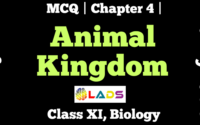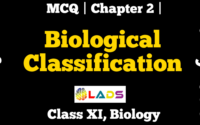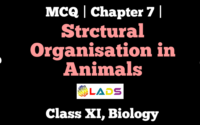MCQ Of Plant Kingdom | Chapter 3 | Class 11 | Biology | CBSE
MCQ Of Plant Kingdom, Chapter 3, Class 11, Biology
Question 1: Artificial systems of classification were based upon
- Vegetative characters
- Androecium structure
- Habit and habitat
- All of these
Answer : D (All of these)
Question 2: Systems of classification were based on natural affinities among the organisms.
- Artificial
- Natural
- Phylogenetic
- Sexual
Answer : B (Natural)
Question 3: Select the incorrect pair.
- Numerical taxonomy – All observable characteristics
- Cytotaxonomy – Cytological information
- Chemotaxonomy – Chromosome number and structure
- Cladistic taxonomy – Origin from a common ancestor
Answer : C (Chemotaxonomy – Chromosome number and structure)
Question 4: Which out of the following are included under tracheophyta i.e., vascular plants?
- Pteridophytes
- Gymnosperms
- Angiosperms
- All of these
Answer : D (All of these)
Question 5: Match Column – I with Column – ll and select the correct option from the codes given below.
| Column – I | Column – II |
| a Non – vascular cryptogams | (i) Gymnosperms, angiosperms |
| b Vascular cryptogams | (ii) Pteridophytes |
| c Phanerogams | (iii) Algae, bryophytes |
- a – (iii), b – (ii), c – (i)
- a – (ii), b – (i), c – (iii)
- a – (i), b – (ii), c – (iii)
- a – (ii), b – (iii), c – (i)
Answer : A (a – (iii), b – (ii), c – (i))
Question 6: Artificial systems gave equal weightage to vegetative and sexual characteristics; this is not acceptable because often ________ characters are more easily affected by environment.
- Vegetative
- Sexual
- Anatomical
- Physiological
Answer : A (Vegetative)
Question 7: Natural systems of classification take into consideration
- Morphological and anatomical characters
- Cytological and embryological characters
- Physiological and reproductive characters
- All of these
Answer : D (All of these)
Question 8: A system of classification in which a large number of traits are considered is
- Artificial system
- Phylogenetic system
- Synthetic system
- Natural system
Answer : D (Natural system)
Question 9: Natural system of classification differs from artificial system in
- Employing only one floral trait
- Employing only one vegetative trait
- Bringing out similarities and dissimilarities
- Developing evolutionary trends
Answer : C (Bringing out similarities and dissimilarities)
Question 10: Plant classification as proposed by Carolus Linnaeus was artificial because it was based on
- Only a few morphological characters
- All the possible characters
- Anatomical characters which are adaptive in nature
- Physiological and morphological characters
Answer : A (Only a few morphological characters)
You may also read MCQ of The Living World, MCQ of Biological Classification, MCQ of Animal Kingdom, MCQ of Morphology of Flowering Plants, MCQ of Structural Organization in Animals, MCQ of Cell: The Unit of Life, MCQ of Biomolecules for better understanding of the chapters.
Question 11: Each character is given equal importance and at the same time hundreds of characters can be considered in
- Cytotaxonomy
- Morphotaxonomy
- Chemotaxonomy
- Numerical taxonomy
Answer : D (Numerical taxonomy)
Question 12: _______ and _______ are unicellular algae, rich in proteins, which are used as food supplements even by space travellers.
- Chlorella, Spirulina
- Gelidium, Gracilaria
- Porphyra, Spirogyra
- Laminaria, Spirogyra
Answer : A (Chlorella, Spirulina)
Question 13: Green algae usually have a rigid cell wall made of an inner layer of and an outer layer of
- Cellulose, Cellulose
- Pectose, Pectose
- Pectose, Cellulose
- Cellulose, Pectose
Answer : D (Cellulose, Pectose)
Question 14: Which of the following is a correct match of algal class with its characteristic reserve food?
- Chlorophyceae – Starch
- Phaeophyceae – Mannitol, laminarin
- Rhodophyceae – Floridean starch
- All of these
Answer : D (All of these)
Question 15: In most green algae, pyrenoids represent the storage bodies located in _______ .
- Chloroplasts
- Mitochondria
- Cytoplasm
- Nucleus
Answer : A (Chloroplasts)
Question 16: Fusion of two gametes which are dissimilar in size is termed as
- Oogamy
- Isogamy
- Anisogamy
- Both A and C
Answer : D (Both A and C)
Question 17: Which of the following pigments are found in brown algae?
- Chl a, Chl c
- Chl a, Chl d
- Chl a, Chl c and fucoxanthin
- Chl a, phycoerythrin
Answer : C (Chl a, Chl c and fucoxanthin)
Question 18: Laminarin and mannitol, the reserve food of brown algae, are
- Lipids
- Complex carbohydrates
- Proteins
- Lipoproteins
Answer : B (Complex carbohydrates)
Question 19: Which out of the following does not belong to brown algae?
- Gelidium, Batrachospermum
- Ectocarpus, Dictyota
- Laminaria, Fucus
- Sargassum, Ectocarpus
Answer : A (Gelidium, Batrachospermum)
Question 20: Which of the following statements about Phaeophyceae is incorrect?
- Vegetative reproduction occurs by fragmentation.
- Asexual reproduction is by biflagellate pear-shaped zoospores.
- In sexual reproduction, gametes are pyriform and bear 2 laterally attached flagella
- None of these
Answer : D (None of these)
Question 21: Photosynthetic pigments of Rhodophyceae (red algae) are
- Chl a and b
- Chl a and c, fucoxanthin
- Chl a and d
- Chl a, d and phycoerythrin
Answer : D (Chl a, d and phycoerythrin)
Question 22: “The seaweeds” that from the under water forest are
- Kelps
- Laminaria
- Macrocystis
- All of these
Answer : D (All of these)
Question 23: In Ulothrix, sexual reproduction is by
- Isogamy
- Anisogamy
- Oogamy
- Conjugation
Answer : A (Isogamy)
Question 24: Which one of the following cannot fix nitrogen?
- Nostoc
- Azotobacter
- Spirogyra
- Anabaena
Answer : C (Spirogyra)
Question 25: Agar – agar is commercially obtained from
- Green algae
- Blue-green algae
- Brown algae
- Red algae
Answer : D (Red algae)
Question 26: Fusion between morphologically alike gametes is referred to as fat
- Isogamy
- Anisogamy
- Oogamy
- Syngamy
Answer : A (Isogamy)
Question 27: What is the characteristic branching pattern of Dictyota thallus ?
- Monopodial
- Excurrent
- Dichotomous
- Deliquescent
Answer : C (Dichotomous)
Question 28: Match Column – I with Column – ll and select the correct option from the codes given below.
| Column – I | Column – II |
| a Spirogyra | (i) Unicellular |
| b Chlamydomonas | (ii) Filamentous |
| c Volvox | (iii) Colonial form |
| d Some giant marine forms | (iv) Kelps |
- a – (ii), b – (i), c – (iii), d – (iv)
- a – (ii), b – (iii), c – (iv), d – (i)
- a – (iii), b – (ii), c – (iv), d – (i)
- a – (iii), b – (ii), c – (i), d – (iv)
Answer : A (a – (ii), b – (i), c – (iii), d – (iv) )
Question 29: The members of Phaeophyceae or brown algae are found primarily in / on
- Fresh water
- Marine habitat
- Terrestrial habitat
- Rock
Answer : B (Marine habitat)
Question 30: Gametophytic generation is dominant in
- Gymnosperms
- Bryophytes
- Pteridophytes
- Angiosperms
Answer : B (Bryophytes)
Question 31: Asexual reproduction in liverworts takes place by
- Fragmentation of thalli and gemmae formation
- Gemmae formation and diploid spore formation
- Spores formation and isogamy
- Fragmentation and zoospore formation
Answer : A (Fragmentation of thalli and gemmae formation)
Question 32: Read the given statements and select the correct option.
STATEMENT 1: Bryophytes are amphibians of plant kingdom
STATEMENT 2 : They live in soil but depend on water for sexual reproduction
- Both statements 1 and 2 are correct and statement 2 is the correct explanation of statement 1.
- Both statements 1 and 2 are correct but statement 2 is not the correct explanation of statement 1.
- Statement 1 is correct and statement 2 is incorrect.
- Both statements 1 and 2 are incorrect.
Answer : A (Both statements 1 and 2 are correct and statement 2 is the correct explanation of statement 1)
Question 33: Resemblances between algae and bryophytes include
- Presence of root – like, stem – like and leaf – like structures
- Thallus – like plant body, lack of vascular tissue, autotrophic nutrition
- Thallus – like plant body, presence of vascular tissue, autotrophic nutrition
- Presence of roots, heterotrophic nutrition.
Answer : B (Thallus – like plant body, lack of vascular tissue, autotrophic nutrition)
Question 34: A moss sperm moves by means of
- Pseudopodia
- Cilia
- Flagella
- Any of these
Answer : C (Flagella)
Question 35: In Funaria, the haploid structure is
- Protonema
- Capsule
- Columella
- Seta
Answer : A (Protonema)
Question 36: First land inhabiting plants are
- Bryophytes
- Angiosperms
- Gymnosperms
- Pteridophytes
Answer : A (Bryophytes)
Question 37: Which is the predominant phase in the life – cycle of a bryophyte ?
- Gametophyte
- Capsule
- Seta
- Sporophyte
Answer : A (Gametophyte)
Question 38: In bryophytes
- Sporophytes are dependent upon gametophytes
- Sporophyte and gametophyte generations are independent
- Sporophyte in itself completes the life cycle
- Gametophytes are dependent upon sporophyte
Answer : A (Sporophytes are dependent upon gametophytes)
Question 39: Bryophytes include
- Liverworts and ferns
- Mosses and ferns
- Mosses and liverworts
- All of these
Answer : C (Mosses and liverworts)
Question 40: The moss which forms dense extensive mats on the soil prevents
- Uprooting of trees
- Soil erosion
- Falling of leaves
- Evaporation of water from the soil
Answer : B (Soil erosion)
Question 41: Which of the following statements is incorrect?
- Mosses along with lichens are the first organisms to colonise rocks
- Sphagnum is used as packing material for transportation of living material
- In liverworts, spores are produced after meiosis within the capsule
- Funaria possesses unicellular unbranched rhizoids
Answer : D (Funaria possesses unicellular unbranched rhizoids)
Question 42: Gemmae are the specialised structures produced in liverworts. These are
- Non-green, multicellular, asexual buds which develop in gemma cups
- Green, multicellular, asexual buds which develop in gemma cups
- Non-green, multicellular, diploid, sexual spores
- Green, unicellular, diploid, sexual spores
Answer : B (Green, multicellular, asexual buds which develop in gemma cups)
Question 43: The spread of living pteridophytes is limited and is restricted to narrow geographical region because of
- Gametophytic growth needs cool, damp and shady places
- Requirement of water for fertilization
- Absence of stomata in leaf and absence of vascular tissue
- Both A and B
Answer : D (Both A and B)
Question 44: Which of the following is an aquatic fern?
- Adiantum
- Dryopteris
- Salvinia
- Equisetum
Answer : C (Salvinia)
Question 45: Heterosporous pteridophytes show certain characteristics, which are precursor to the ‘seed habit’ in gymnosperms. One of such characteristics is
- Presence of vascular tissues
- External water required for fertilization
- Presence of embryo stage
- Development of embryo inside the female gametophyte
Answer : D (Development of embryo inside the female gametophyte)
Question 46: Match Column – I with Column – ll and select the correct option from the codes given below.
| Column – I | Column – II |
| a Psilopsida | (i) Psilotum |
| b Lycopsida | (ii) Equisetum |
| c Sphenopsida | (ii) Equisetum |
| d Pteropsida | (iv) Dryopteris |
- a – (i), b – (ii), c – (iii), d – (iv)
- a – (i), b – (iv), c – (iii), d – (ii)
- a – (i), b – (iii), c – (ii), d – (iv)
- a – (i), b – (iii), c – (iv), d – (ii)
Answer : C (a – (i), b – (iii), c – (ii), d – (iv))
Question 47: Plants which posseses seeds but not fruits are
- Bryophytes
- Pteridophytes
- Gymnosperms
- Angiosperms
Answer : C (Gymnosperms)
Question 48: Select the correct pattern of arrangement of reproductive structures for gymnosperms.
- Spores → Sporophylls → Sporangia → Strobili
- Spores → Sporangia → Sporophylls → Strobili
- Sporangia → Sporophylls → Spores → Strobili
- Spores → Sporangia → Strobili → Sporophylls
Answer : B (Spores → Sporangia → Sporophylls → Strobili)
Question 49: Which of the following statements is incorrect about Cycas?
- It has unbranched stem
- It possesses pinnately compound leaves
- It is a dioecious plant
- It is a non-archegoniate plant
Answer : D ( It is a non-archegoniate plant)
Question 50: Study the given statements about gymnosperms and select the correct option.
(i) Mode of fertilization is siphonogamy.
(ii) Male and female cones are borne on same tree in Pinus.
(iii) Endosperm represents female gametophyte.
- Statements (i) and (ii) are correct
- Statements (ii) and (iii) are correct
- Statements (i) and (iii) are correct
- Statements (i), (ii) and (iii) are correct
Answer : D (Statements (i), (ii) and (iii) are correct)
Question 51: Which of the following gymnosperms has branched stems?
- Pinus
- Cycas
- Cedrus
- Both A and C
Answer : D (Both A and C)
Question 52: Coralloid roots of _______ have symbiotic association with N2 – fixing cyanobacteria.
- Pinus
- Cedrus
- Cycas
- Ginkgo
Answer : C (Cycas)
Question 53: Mycorrhizal roots of ________ are associated with some fungal symbionts.
- Pinus
- Cedrus
- Cycas
- Ginkgo
Answer : A (Pinus)
Question 54: Match Column – I with Column – II and select the correct option from the codes given below.
| Column – I | Column – II |
| a. Sagopalm | (i) Ephedra |
| b. Chilgoza fruit | (ii) Pinus gerardiana |
| c. Ephedrine drug | (iii) Cycas revoluta |
| d. Cedar wood oil | (iv) Juniperus virginiana |
- a – (iv), b – (ii), c – (i), d – (iii)
- a – (iii), b – (ii), c – (i), d – (iv)
- a – (iii), b – (iv), c – (i), d – (ii)
- a – (ii), b – (iii), c – (i), d – (iv)
Answer : B (a – (iii), b – (ii), c – (i), d – (iv))
Question 55: Gymnosperms do not include
- Herbs
- Shrubs
- Trees
- Both A and B
Answer : A (Herbs)
Question 56: Megasporophyll of gymnosperms is homologous to _________ of angiosperms.
- Stamen
- Carpel
- Sepal
- Petal
Answer : B (Carpel)
Question 57: Gymnosperms do not bear fruits because they do not have
- Seeds
- Ovary
- Ovule
- Pollination
Answer : B (Ovary)
Question 58: Heterospory is found in some members of _________ and all members of _________ .
- Bryophyta, Pteridophyta
- Pteridophyta, Bryophyta
- Bryophyta, Gymnospermae
- Pteridophyta, Spermatophyta
Answer : D (Pteridophyta, Spermatophyta)
Question 59: Select the mismatched pair.
- Amphibians of plant kingdom – Bryophytes
- First terrestrial plants to possess vascular tissues – Gymnosperms
- Water required for fertilization – Pteridophytes
- Seeds enclosed in fruits – Angiosperms
Answer : B (First terrestrial plants to possess vascular tissues – Gymnosperms)
Question 60: In angiosperms, functional megaspore develops into
- Embryo sac
- Ovule
- Endosperm
- Pollen sac
Answer : A (Embryo sac)
Question 61: Match Column – I with Column – ll and select the correct option from the codes given below.
| Column – I | Column – II |
| a Pteris | (i) Bryophyte |
| b Cedrus | (ii) Pteridophyte |
| c Sonchus | (iii) Gymnosperm |
| d Marchantia | (iv) Angiosperm |
- a-(ii), b-(iii), c-(iv), d-(i)
- a-(ii), b-(i), c-(iv), d- (iii)
- a-(i), b-(iii), c-(iv), d-(ii)
- a-liii), b-(iv), c-(ii), d-(i)
Answer : A ( a-(ii), b-(iii), c-(iv), d-(i))
Question 62: Which of the following characters represent the affinities of Gnetum with angiosperms and differences with Cycas and Pinus?
- Presence of xylem vessels and absence of archegonia
- Perianth and two integuments
- Embryo development and apical meristem
- Absence of resin ducts and leaf venation
Answer : A (Presence of xylem vessels and absence of archegonia)
Question 63: Read the given statements and select the incorrect ones.
(i) Sporophyte in mosses is more elaborate than that in liverworts.
(ii) Salvinia is homosporous.
(iii) Life-cycle in all spermatophytes is diplontic.
(iv) In Cycas, male cones and megasporophylls are borne on the same trees.
- (i) and (ii)
- (i) and (iii)
- (ii) and (iv)
- (iii) and (iv)
Answer : C ((ii) and (iv))
Question 64: Haplo – diplontic life cycle is found in
- Bryophytes
- Pteridophytes
- Fungi
- Both A and B
Answer : D (Both A and B)
Question 65: Which kind of life – cycle pattern is exhibited by seed – bearing plants?
- Haplontic
- Diplontic
- Haplo-diplontic
- All of these
Answer : B (Diplontic)
Question 66: In _________ , a dominant and independent haploid gametophyte alternates with a short – lived, dependent sporophyte.
- Algae
- Bryophytes
- Pteridophytes
- Gymnosperms
Answer : B (Bryophytes)
Do share the post if you liked the MCQ of Plant Kingdom. For more updates, keep logging on BrainyLads



